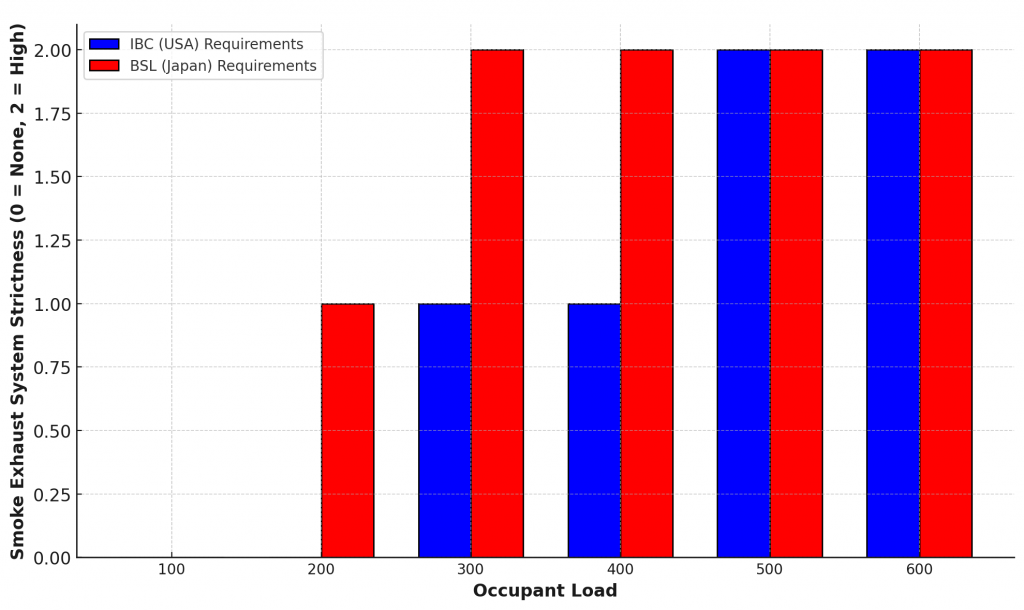General Definition
- Smoke control systems are active or passive ventilation systems designed to limit smoke migration during a fire, ensuring clear evacuation routes and reducing occupant exposure to toxic gases.
- These systems are critical in Group A-1 occupancies, such as theaters, concert halls, and auditoriums, where large crowds require safe egress pathways and protection from smoke accumulation.
- Building codes, such as the International Building Code (IBC) and the Building Standards Law (BSL) of Japan, establish minimum requirements for mechanical smoke exhaust, stairwell pressurization, and emergency power provisions for effective smoke management.

Comparison Table
| Element | IBC Table 909 (USA) – Smoke Control System Requirements for A-1 Occupancy | BSL Articles 17 & 35 (Japan) – Smoke Management Regulations |
| Smoke Control Requirement Threshold | – Required for A-1 occupancies with ≥500 occupants. | – Required for A-1 occupancies with ≥300 occupants. (Stricter than IBC.) |
| Mechanical vs. Natural Ventilation | – Mechanical smoke control required for high-occupancy venues. – Natural ventilation allowed in specific cases. | – Prefers mechanical systems; allows natural ventilation in small venues. (BSL leans toward stricter mechanical smoke control.) |
| Pressurization for Exit Stairwells | – Stairwells must be positively pressurized to prevent smoke ingress. | – Same requirement, but stricter testing for high-rise assembly buildings. |
| Smoke Control for Stages & Platforms | – Smoke control required for stages >1,000 sq. ft. (93 m²). | – Stricter requirement—smoke exhaust required for stages >500 sq. ft. (46.5 m²). |
| Emergency Power for Smoke Control Systems | – Emergency backup required for mechanical smoke control systems. – Power must last at least 2 hours. | – Same requirement as IBC. (No major differences.) |
Key Differences
- Occupant Load Threshold for Smoke Control:
- IBC mandates smoke control for venues with 500+ occupants.
- BSL applies a stricter threshold, requiring smoke control for venues with 300+ occupants.
- Mechanical vs. Natural Ventilation:
- IBC allows some use of natural ventilation in smaller venues.
- BSL generally prefers mechanical systems and enforces stricter smoke exhaust requirements.
- Smoke Control for Stages & Platforms:
- IBC requires smoke control for stages >1,000 sq. ft. (93 m²).
- BSL enforces smoke control for smaller stages >500 sq. ft. (46.5 m²). (Stricter requirement.)
Recommendations for Improvement
| Issue | IBC Recommendation | BSL Recommendation |
| Lower Occupant Threshold for Smoke Control | Reduce occupant load threshold to 300, similar to BSL, for added safety. | Maintain stricter smoke control but clarify small venue exemptions. |
| Stronger Mechanical Ventilation Requirements | Require mechanical smoke exhaust in all enclosed assembly venues. | Consider allowing more flexibility for small naturally ventilated venues. |
| Stricter Smoke Control for Stages | Apply BSL’s stricter requirements for smoke exhaust on smaller stages. | Improve testing criteria for smoke control system effectiveness. |
Key Insights
- Smoke Control Requirement Threshold:
- IBC: Required for venues with 500+ occupants.
- BSL: Stricter requirement—mandates smoke control at 300 occupants.
- Mechanical vs. Natural Ventilation:
- IBC: Allows some natural ventilation in smaller venues.
- BSL: Prefers mechanical smoke control in all cases. (Stricter.)
- Pressurization for Exit Stairwells:
- Both IBC & BSL require positive pressurization of stairwells to prevent smoke infiltration.
- Smoke Control for Stages & Platforms:
- IBC: Smoke exhaust required for stages >1,000 sq. ft.
- BSL: Stricter requirement—smoke exhaust required for stages >500 sq. ft.
- Emergency Power for Smoke Control Systems:
- Both IBC and BSL require backup power for at least 2 hours.
Summary
- BSL enforces stricter smoke control requirements than IBC for A-1 occupancies.
- IBC allows a higher occupancy threshold (500 occupants) before requiring smoke control, while BSL enforces requirements at 300 occupants.
- BSL favors mechanical smoke exhaust over natural ventilation, ensuring better smoke control.
- BSL enforces stricter smoke exhaust requirements for smaller stages and platforms than IBC.
- Both codes align in requiring stairwell pressurization and emergency power backup for smoke control systems.
